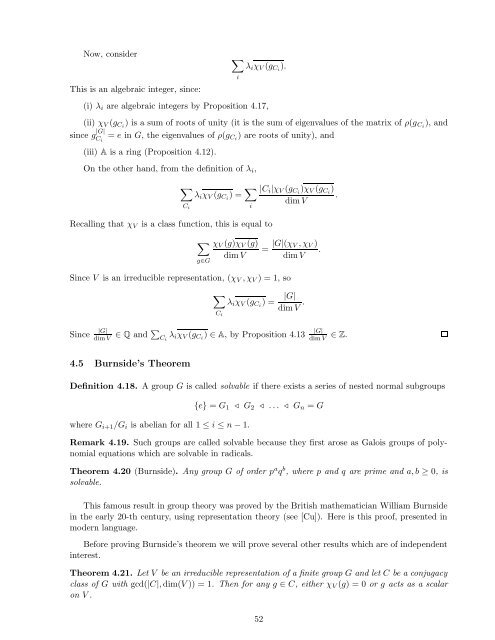Lecture notes for Introduction to Representation Theory
Lecture notes for Introduction to Representation Theory
Lecture notes for Introduction to Representation Theory
You also want an ePaper? Increase the reach of your titles
YUMPU automatically turns print PDFs into web optimized ePapers that Google loves.
Now, consider <br />
∂i ν V (g Ci ).<br />
This is an algebraic integer, since:<br />
(i) ∂ i are algebraic integers by Proposition 4.17,<br />
i<br />
(ii) ν V (g Ci ) is a sum of roots of unity (it is the sum of eigenvalues of the matrix of δ(g Ci ), and<br />
|G |<br />
since g C = e in G, the eigenvalues of δ(gCi ) are roots of unity), and<br />
i<br />
(iii) A is a ring (Proposition 4.12).<br />
On the other hand, from the definition of ∂ i ,<br />
<br />
∂i ν V (g Ci ) = |C i |ν V (g Ci )ν V (g Ci ) .<br />
dim V<br />
Recalling that ν V is a class function, this is equal <strong>to</strong><br />
C i<br />
i<br />
νV (g)ν V (g) |G|(ν V , ν V ) = .<br />
dim V dim V<br />
gG<br />
Since V is an irreducible representation, (ν V , ν V ) = 1, so<br />
<br />
∂i ν V (g Ci ) =<br />
C i<br />
|G|<br />
.<br />
dim V<br />
|G|<br />
Since dim<br />
V<br />
Q and ⎨ C i<br />
∂ i ν V (g Ci ) A, by Proposition 4.13 dim V<br />
Z.<br />
|G|<br />
4.5 Burnside’s Theorem<br />
Definition 4.18. A group G is called solvable if there exists a series of nested normal subgroups<br />
where G i+1 /G i is abelian <strong>for</strong> all 1 ∗ i ∗ n − 1.<br />
{e} = G 1 γ G 2 γ . . . γ G n = G<br />
Remark 4.19. Such groups are called solvable because they first arose as Galois groups of polynomial<br />
equations which are solvable in radicals.<br />
a<br />
Theorem 4.20 (Burnside). Any group G of order p q b , where p and q are prime and a, b ⊂ 0, is<br />
solvable.<br />
This famous result in group theory was proved by the British mathematician William Burnside<br />
in the early 20-th century, using representation theory (see [Cu]). Here is this proof, presented in<br />
modern language.<br />
Be<strong>for</strong>e proving Burnside’s theorem we will prove several other results which are of independent<br />
interest.<br />
Theorem 4.21. Let V be an irreducible representation of a finite group G and let C be a conjugacy<br />
class of G with gcd(|C|, dim(V )) = 1. Then <strong>for</strong> any g C, either ν V (g) = 0 or g acts as a scalar<br />
on V .<br />
52

















